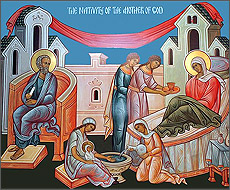
Great Vespers in the Eastern Rite (my family and I are Byzantine Catholics) includes something called the Apostichon or “hymns on the verses,” a chanted reflection on the mystery being celebrated, tied to related verses from the Psalms. Yesterday’s Apostichon included the following lines:
Behold: No woman will ever again bear a child in sorrow or anxiety,
for joy has come forth in abundance and life has filled the world.
As a pro-life activist—as one who regularly beholds women bearing children in such sorrow and anxiety that they choose to abort the lives of those children—these lines struck me. How can we say that “No woman will ever again bear a child in sorrow or anxiety”?
A “Double Mystery” of Joy
I’m neither liturgist nor theologian—only a mere cantor—but here’s my take on it:
Many of the refrains from Great Vespers for this feast focus on a sort of “double joy” in Mary’s birth. Not only has the barren Anne miraculously given birth, but the child she has borne will give birth even more miraculously—as a virgin.
Both the woman who has sought unsuccessfully to become a mother and the woman who never sought to become a mother at all are blessed by this feast; from “virgin” to “barren” in a sense covers the whole territory of childbearing anxiety and sorrow.
The verses chanted in the Eastern Rite tend to have a kind of idealism about them—an ecstatic optimism, sometimes seen in hyperbole. So it is not the case that literally no woman will ever bear a child in sorrow and anxiety (as no doubt the venerable monk who composed this recognized), but that the mysteries revealed in this feast ought to drive out all such sorrow and anxiety.
Or to look at it another way: Often the verses we chant in the Eastern Rite take a rather eschatological view of things. Once the mystery is complete—once Christ’s dominion over all creation is finally established (this feast being a necessary component of that work), then the words of this verse come true.
That Life May Fill the World
But however you look at it, a duty falls upon our shoulders to work towards that goal. Our first mission must be to drive out all of the anxiety and sorrow surrounding childbirth, so that no woman will be overwhelmed by it and choose to abort her child.
The double-mystery of this feast, centered on the bearing of children, can help us to remember that “Joy has come forth in abundance and life has filled the world.”
